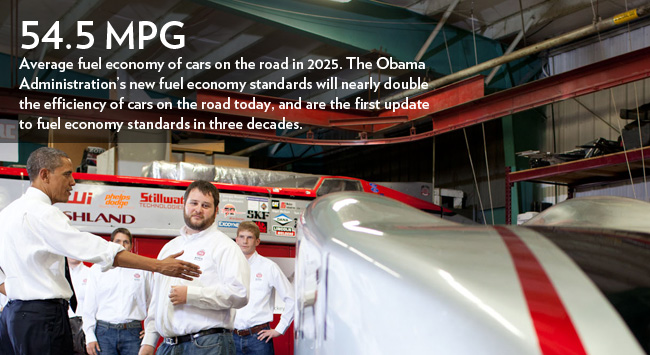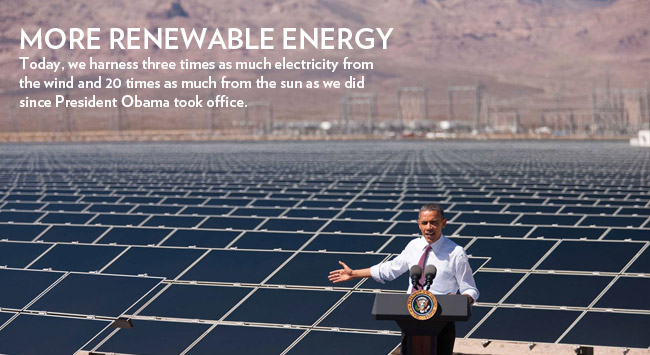Energy and Environment Latest News
Our Endangered Climate: Kicking off Public Health Week
Posted by on April 7, 2015 at 9:00 PM EDTYesterday, President Obama issued a Presidential Proclamation declaring this week, April 6-12, 2015, as National Public Health Week.
As part of the effort to support public health with a sense of purpose and determination, the Obama administration has focused on how climate change affects our environment. Our public health is deeply tied to the health of our environment. As the planet warms, we face new threats to our health and well-being, and the President is taking steps to counteract those threats.
Today, President Obama spoke at Howard University Medical School in Washington, D.C., joined by the Surgeon General, Dr. Vivek Murphy, and Gina McCarthy, the head of the Environmental Protection Agency, at a roundtable. The President explained what the Administration has already done to reduce the dangerous levels of carbon dioxide that are contributing to climate change, and discussed ways to prepare our communities for the impacts that cannot be avoided.
Learn more about Energy and EnvironmentContinuing Our Focus on Solar Energy
Posted by on April 3, 2015 at 6:51 PM EDTToday, President Obama visited Hill Air Force Base in Salt Lake City, Utah to host a roundtable on clean energy, tour solar installations on the base, and talk about the importance of clean energy jobs.
With the United States generating 20 times more solar electricity than when the President took office, we’ve made substantial progress -- and in his remarks today, the President announced more actions to drive growth in the solar industry while supporting our nation's veterans.
Learn more about Energy and EnvironmentDriving renewable progress in the Federal Government
Posted by on April 3, 2015 at 5:23 PM EDTEarlier today, the Administration announced new actions to drive growth in the solar industry while also supporting our veterans. Since the President took office, solar electricity generation has increased 20 fold, doubling last year alone.
In the Federal Government, we’re doing our part to drive solar growth. On Wednesday, I visited the Army’s Fort Detrick base in Maryland to break ground on an exciting new solar energy project. The project – which includes more than 60,000 solar panels across 67 acres – will help the base meet its electricity needs by producing 15 megawatts of renewable solar energy, enough to power approximately 2,500 homes.
Projects like this are a great example of how Federal facilities are making huge strides toward cleaner energy production and greater energy independence. They also help ensure that the Federal Government does its part to curb the greenhouse gas emissions that drive climate change. For example, the Fort Detrick solar array will cut greenhouse gases by 19,000 metric tons of carbon dioxide each year. That’s equivalent to the carbon absorbed by more than 487,000 trees.
Last year, through the Capital Solar Challenge, the President challenged Federal agencies and military installations to deploy more solar energy on rooftops, covered parking, and open land. The Fort Detrick groundbreaking marked the first project launched under the Challenge.
And it’s not just the Army stepping up. Other Federal agencies and branches of the U.S. Military are making progress to meet the President’s goals. Also this week, the General Services Administration (GSA) announced a project to produce 5 megawatts of solar on nine GSA and U.S. Forest Service rooftops in California and Nevada. GSA also awarded two contracts for a total of 81 megawatts of new grid-based solar in Maryland. This project is part of a larger green power initiative issued last year for grid-based green power across regional markets, including a 140 MW wind project in Illinois.
The Navy has found success using a similar regional model. They have already announced plans to install new renewable energy projects to power 14 installations in California, and up to 55 megawatts of new renewable for three installations in Texas, as well as new projects for ten Naval installations in the Mid-Atlantic. The entire Department of Defense is leading the way, making significant progress toward their Climate Action Plan goal of deploying 3 gigawatts of renewable energy by 2025. Over the past year, the Air Force developed a 16 megawatt solar array at Davis-Monthan Air Force Base, Arizona and plans to expand its use of renewable energy with more than 160 megawatts under development. And in addition to the project at Fort Detrick, the Army has announced three 30 megawatt solar arrays at installations in Georgia, the first of which is breaking ground later this month.
All of this progress has an impact outside the Federal Government. For example, the Department of Defense’s steadfast commitment to deploying renewables is driving the development of clean energy technologies across the sector. And by leveraging private sector financing through energy savings performance contracts, they are making these strides without costing taxpayers an extra dime.
This is what leading by example look like. All of these projects will help the Federal Government meet the President’s new goal to cut greenhouse gas emissions 40 percent from 2008 levels by 2025. As President Obama continues to take action to curb emissions and support clean energy, he will continue to rely on the impressive leadership Federal agencies are showing.
Christy Goldfuss is Managing Director of the White House Council on Environmental Quality.
Learn more about Energy and EnvironmentWhat They're Saying: Environmental Advocates Point to the Trans-Pacific Partnership as a Historic Opportunity to Protect Our Oceans, Forests, and Wildlife
Posted by on March 31, 2015 at 11:28 AM EDTThe Trans-Pacific Partnership (TPP) offers a substantial opportunity to advance American interests and values, including a once-in-a-generation chance to protect our oceans, wildlife, and the environment.
The Asia-Pacific Region and TPP parties encompass some of the world’s most ecologically significant regions, are home to major markets for wildlife and wildlife products, and include eight of the top 20 fishing nations, together accounting for a quarter of global marine catch and seafood exports. Taking action in the region is of critical importance given that five of the TPP parties are among the world’s 17 “mega-diverse” countries, a group covering less than 10 percent of the earth’s area, but supporting more than 70 percent of the earth’s species plant and animal species.
Through TPP, the Obama administration is doubling down on its commitment to use every tool possible to address the most pressing environmental challenges. We aren’t just talking about holding trading partners accountable for protecting wildlife, forests, and oceans; we plan to make those environmental commitments fully enforceable in the core of the TPP agreement, on equal footing with the economic obligations our trading partners take on.
Learn more about , Economy, Energy and EnvironmentGet Out and #FindYourPark
Posted by on March 30, 2015 at 8:03 PM EDT"For a century, rangers, and interpreters, and volunteers and visitors have kept alive what the writer Wallace Stegner once called 'the best idea we ever had' — our belief that the country’s most special places should belong not just to the rich, not just to the powerful, but belong to everybody — not just now, but for all time."
— President Obama
Next year, the National Park Service celebrates its 100th birthday. That marks 100 years of preserving, restoring, and sharing some of America's most special places — from gorgeous, iconic landscapes like Yellowstone and Yosemite to the sites across the country that tell the stories of people and events that have shaped our history. Our parks are an essential part of our heritage and a source of great pride. And, most importantly, our parks belong to all of us.
That’s a lot to celebrate, so we’re starting now. Last month, President Obama kicked things off when he launched Every Kid in a Park — an initiative that will give every fourth-grade student and their families a free pass to National Parks and all other federal lands and waters for a full year.
And today, the National Park Service and National Park Foundation are continuing the celebration with the launch of #FindYourPark, a new campaign to encourage Americans to connect to our astounding network of parks and public lands — whether it’s for the first time or the hundredth.
Learn more about Energy and EnvironmentHighlighting our National Ocean Policy
Posted by on March 27, 2015 at 1:48 PM EDTSince President Obama created America’s first National Ocean Policy in 2010, Federal agencies have made tremendous progress to meet its objectives – working every day with communities across the Nation and stakeholders on the ground to improve the health of our oceans, support our economy, bolster safety and security, and better understand how our activities impact the ocean.
Today, we are releasing the first Report on the Implementation of the National Ocean Policy, which highlights the progress we’ve made since we released an action plan last year. From supporting the ocean economy to ensuring the security of our ports and waterways, and from improving coastal and ocean resilience to providing local communities with tools to plan for a better future, we’ve made tremendous strides in undertaking our role as responsible stewards of this Nation’s great oceans.
Among the activities described are a host of steps to promote sustainable energy development and aquaculture practices—including ensuring that permitting processes for these activities are efficient and streamlined as possible; advancing research and monitoring activities to help protect people and communities from harmful algal blooms; developing data-driven tools to map the extent of sea-ice and to assist emergency responders and environmental resources managers in dealing with incidents in the Arctic region that may harm the environment; and issuing step-by-step guidance to help coastal communities asses vulnerabilities and develop plans to cope with the impacts of climate change, extreme weather, and ocean acidification.
Our oceans, coasts, and Great Lakes provide us with rich cultural, recreational, and commercial opportunities. Collectively, these treasured waters support tens of millions of jobs and contribute trillions of dollars a year to the national economy. The actions underway across Federal agencies and in collaboration with states, regions, and communities will ensure that our oceans resources remain safe and healthy, and that our ocean economy continues to thrive for the benefit of all Americans.
To read the report, click here.
Beth Kerttula is Director of the National Oceans Council.
Learn more about Energy and Environment
- &lsaquo previous
- …
- 9
- 10
- 11
- 12
- 13
- 14
- 15
- 16
- 17
- …
- next &rsaquo
White House Blogs
- The White House Blog
- Middle Class Task Force
- Council of Economic Advisers
- Council on Environmental Quality
- Council on Women and Girls
- Office of Intergovernmental Affairs
- Office of Management and Budget
- Office of Public Engagement
- Office of Science & Tech Policy
- Office of Urban Affairs
- Open Government
- Faith and Neighborhood Partnerships
- Social Innovation and Civic Participation
- US Trade Representative
- Office National Drug Control Policy









